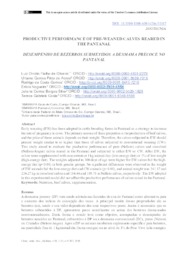Productive performance of pre-weaned calves reared in the Pantanal.
Productive performance of pre-weaned calves reared in the Pantanal.
Author(s): OLIVEIRA, L. O. F. de; ABREU, U. G. P. de; GOMES, R. da C.; NOGUEIRA, E.; SILVA, J. C. B.; COSTA, T. G.
Summary: Early weaning (EW) has been adopted in cattle breeding farms in Pantanal as a strategy to increase the rate of pregnancy in cows. The primary income of these properties is the production of beef calves, and the price of these animals depends on their weight. Therefore, the calves subjected to EW should present weight similar to or higher than those of calves subjected to conventional weaning (CW). This study aimed to evaluate the productive performance of pure (Nellore) calves and crossbred (Nellore/Angus) calves reared in the Pantanal and subjected to either EW or CW. After EW, the calves were supplemented with concentrate at 1 kg/animal/day (low-energy diet) or 1% of live weight (high-energy diet). The weights adjusted to 300 days of age were higher for EW calves fed the highenergy diet (p<0.01) in both genetic groups. No significant differences were observed in the weight of EW animals fed the low-energy diet and CW animals (p>0.01), and animal weight was 241.17 and 236.27 kg in crossbred calves and 184.44 and 189.78 in Nellore calves, respectively. The EW adopted in this experimental model did not affect the productive performance of calves raised in the Pantanal.
Publication year: 2019
Types of publication: Journal article
Unit: Embrapa Beef Cattle
Keywords: Beef calves, Bezerro de Corte, Nutrition, Nutrição, Suplementação, Supplementation
Observation
Some of Embrapa's publications are published as ePub files. To read them, use or download one of the following free software options to your computer or mobile device. Android: Google Play Books; IOS: iBooks; Windows and Linux: Calibre.
Access other publications
Access the Agricultural Research Database (BDPA) to consult Embrapa's full library collection and records.
Visit Embrapa Bookstore to purchase books and other publications sold by Embrapa.

